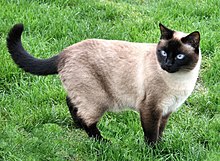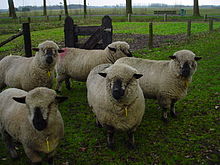Point coloration
This article or section is in a state of significant expansion or restructuring. You are welcome to assist in its construction by editing it as well. If this article or section has not been edited in several days, please remove this template. If you are the editor who added this template and you are actively editing, please be sure to replace this template with {{in use}} during the active editing session. Click on the link for template parameters to use.
This article was last edited by Iamnotabunny (talk | contribs) 0 seconds ago. (Update timer) |

Point coloration is animal coat coloration with a pale body and relatively darker extremities, i.e. the face, ears, feet, tail, and (in males) scrotum. It is most recognized as the coloration of Siamese and related breeds of cat, but can be found in dogs, rabbits, rats, sheep, guinea pigs and horses as well.
Colorpoint patterns
[edit]The most well-known form of point coloration is colorpoint. This pattern can be seen in cats, rats, rabbits, guinea pigs, and rarely dogs.
In horses
[edit]
The name given to a horse's coat color depends on the color of both the points and the body. Bay horses have a reddish-brown body with black points, which include the mane, tail, lower legs, and ear rims.[1]
In horses, point coloration is most often produced by the action of the agouti gene. It acts on the extension gene, when present, to suppress black color to all but the extremities of the horse; the legs, mane, tail and tips of the ears. If the extension gene is not present, the effect of agouti is not visible, as there is no black color present to suppress.
Other genes white markings may affect a horse's coat color in addition to agouti, and if present, can further alter or suppress black hair color and may mask any point coloration. In particular, Gray horses are born dark and lighten with age; if born bay, they will eventually lose point coloration as the body hair silvers with age, though often the points are the slowest areas of the body to go gray.
Point coloration may also be visible on horses with other dilution genes that act upon a bay base coat. These include:
- The cream gene, an incomplete dominant, that when heterozygous produces Buckskin. When homozygous, even point coloration is mostly suppressed, the color is called perlino, and some individuals may have slightly redder hair at the traditional point coloration locations.
- The Champagne gene, which on a bay base produces Amber Champagne.
A dilution gene that produces what looks like point coloration, but from a completely different genetic mechanism is the dominant Dun gene, which dilutes the color of the body coat but not the points, including primitive markings—a dorsal stripe down the back and, less often, horizontal striping on the upper legs. On a bay base coat the dun gene leaves black points, producing a Bay Dun or "Zebra" Dun. But the gene also leaves the points dark when it appears with other base colors. These include the “blue dun” or grullo, which has a black base coat, and the red dun, which has a chestnut base coat.
Similarly, darker coloration at the points is also preserved in horses with the roan gene, a patterning gene, producing a body coat of mingled white and dark hairs, but leaving the points the darker base color in all horses, not just those carrying agouti.
Most other genes that produce spotting patterns or white markings allow point coloration produced by agouti to show except where masked by white depigmentation. There are not always separate names for a pattern over a bay base coat, but one exception is the Bay pinto, sometimes called ”tricoloured”.
-
White markings may partially or completely mask point coloration in horses
-
The dun gene leaves the points darker on all base coat colors, not just when agouti is present
-
The roan pattern allows point coloration to show on the head as well as traditional point locations
In donkeys
[edit]In donkeys, the term "points" refers to the muzzle, rings around the eyes, belly, and upper inner legs, which are usually light in color. The mane, tail, and ear rims are referred to as "trim" and roughly correspond to the "points" of horses. Most donkeys have light points. The coat colors without light points may be called "no light points", "dark points", or "black points". Dark points are caused by a recessive allele of agouti found in Normand and Miniature donkeys. The light areas may vary in extent, with some donkeys having a dark nose but with light areas on the insides of the legs.[1]
In sheep
[edit]
Some breeds of sheep exhibit point coloration.
Suffolk sheep have white fleece with a black head and legs.[2]
Sheep breeds
[edit]References
[edit]- ^ a b Sponenberg, D. Phillip; Bellone, Rebecca (2017). Equine Color Genetics (4 ed.). Wiley Blackwell. pp. 5, 6, 23, 253, 275.
- ^ "Suffolk Breed Standards" (PDF). United Suffolk Sheep Association. Retrieved Sep 28, 2024.




